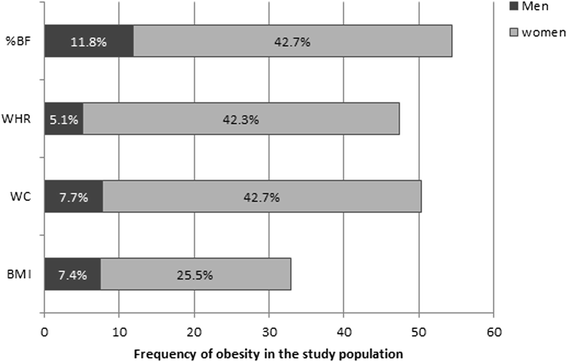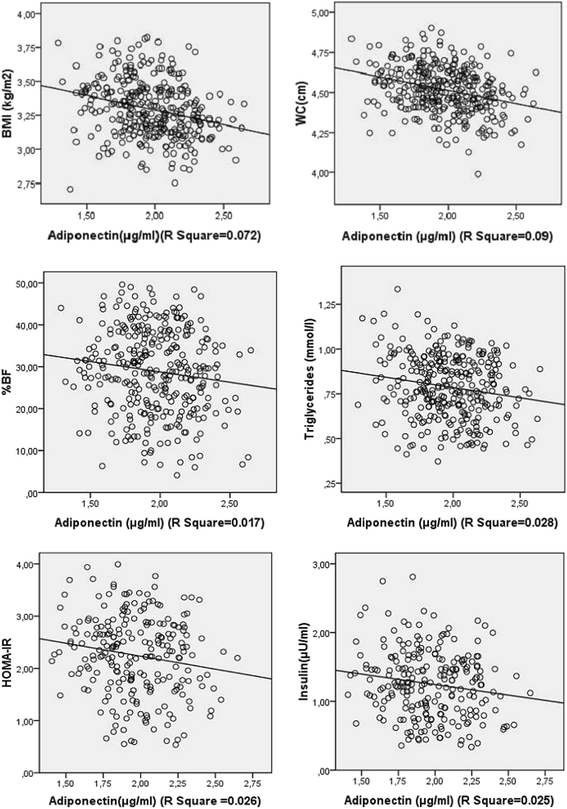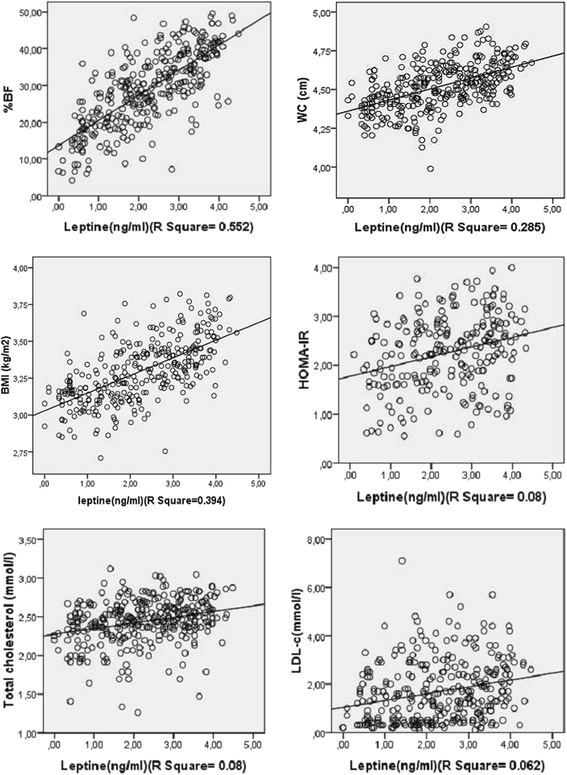Association of serum leptin and adiponectin with anthropomorphic indices of obesity, blood lipids and insulin resistance in a Sub-Saharan African population
- PMID: 27189377
- PMCID: PMC4869296
- DOI: 10.1186/s12944-016-0264-x
Association of serum leptin and adiponectin with anthropomorphic indices of obesity, blood lipids and insulin resistance in a Sub-Saharan African population
Abstract
Background: There is little data on the metabolic effects of adipokines in sub-Saharan African populations. This study aimed to explore the potential relationship of leptin and adiponectin, with obesity, plasma lipids and insulin resistance in a Cameroonian population.
Methods: We enrolled 167 men and 309 women aged ≥18 years from the general population in Cameroon. Data were collected on waist circumference (WC), body mass index (BMI), waist-to-hip ratio (WHR), body fat (BF%), fasting blood glucose, plasma lipids, adiponectin, leptin, insulin and homeostasis model for assessment of insulin resistance (HOMA-IR). Pearson's correlation and multiple stepwise linear regression analyses were used to determine correlates of leptin and adiponectin serum levels.
Results: The prevalence of obesity was higher in women compared to men (p < 0.0001), and Central obesity which is more prevalent particularly in women (WC = 42.4%, WHR = 42.3%), is almost for 90% comparable to %BF (42.7%). Adiponectin negatively with BMI (r = -0.294, p < 0.0001), WC (r = -0.294, p < 0.0001), %BF (r = -0.122, p = 0.028), WHR (r = -0.143, p = 0.009), triglycerides (r = -0.141, p = 0.011), HOMA-IR (r = -0.145, p = 0.027) and insulin (r = -0.130, p = 0.048). Leptin positively correlated with BMI (r = 0.628), WC (r = 0.530), BF% (r = 0.720), (all p < 0.0001); with DBP (r = 0.112, p = 0.043), total cholesterol (r = 0.324, p < 0.0001), LDL-cholesterol (r = 0.298, p < 0.0001), insulin (r = 0.320, p < 0.001 and HOMA-IR (r = 0.272, p < 0.0001). In multiple stepwise regression analysis, adiponectin was negatively associated with WC (β = -0.38, p = 0.001) and BF% (β = 0.33, p < 0.0001), while leptin was positively associated with BF% (β = 0.60, p < 0.0001), total cholesterol (β = 0.11, p = 0.02) and HOMA-IR (β = 0.11, p = 0.02). When controlled for gender, HOMA-IR was found significantly associated to adiponectin (β = 0.13, p = 0.046), but not BF%, while the association previously found between leptin and HOMA-IR disappeared; BMI and WC were significantly associated with leptin (β = 0.18, p = 0.04 & β = 0.19, p = 0.02 respectively).
Conclusion: This study, which includes a population who was not receiving potentially confounding medications, confirms the associations previously observed of adiponectin with reduced adiposity especially central adiposity and improved insulin sensitivity. Confirmatory associations were also observed between leptin and obesity, blood lipids and insulin resistance for the first time in an African population. Gender was significant covariate interacting with insulin sensitivity/insulin resistance and obesity indexes associations in this population.
Keywords: Adipokines; Adiponectin; Blood lipids; Insulin resistance; Insulin sensitivity; Leptin; Obesity indices.
Figures



Similar articles
-
Comparison between body mass index and a body shape index with adiponectin/leptin ratio and markers of glucose metabolism among adolescents.Ann Hum Biol. 2017 Sep;44(6):489-494. doi: 10.1080/03014460.2017.1327617. Epub 2017 May 25. Ann Hum Biol. 2017. PMID: 28482705
-
Neck circumference: a useful screening tool of cardiovascular risk in children.Pediatr Obes. 2012 Jun;7(3):187-95. doi: 10.1111/j.2047-6310.2012.00052.x. Epub 2012 Apr 13. Pediatr Obes. 2012. PMID: 22505226
-
Body adiposity index and other indexes of body composition in the SAPHIR study: association with cardiovascular risk factors.Obesity (Silver Spring). 2013 Apr;21(4):775-81. doi: 10.1002/oby.20289. Obesity (Silver Spring). 2013. PMID: 23712981
-
Adiponectin Resistance in Obesity: Adiponectin Leptin/Insulin Interaction.Adv Exp Med Biol. 2024;1460:431-462. doi: 10.1007/978-3-031-63657-8_15. Adv Exp Med Biol. 2024. PMID: 39287861 Review.
-
Cardiometabolic and obesity risk outcomes of dawn-to-dusk, dry intermittent fasting: Insights from an umbrella review.Clin Nutr ESPEN. 2025 Jun;67:127-145. doi: 10.1016/j.clnesp.2025.03.006. Epub 2025 Mar 11. Clin Nutr ESPEN. 2025. PMID: 40081802
Cited by
-
Brown adipose tissue-derived MaR2 contributes to cold-induced resolution of inflammation.Nat Metab. 2022 Jun;4(6):775-790. doi: 10.1038/s42255-022-00590-0. Epub 2022 Jun 27. Nat Metab. 2022. PMID: 35760872 Free PMC article.
-
Obesity and chronic kidney disease: prevalence, mechanism, and management.Clin Exp Pediatr. 2021 Oct;64(10):511-518. doi: 10.3345/cep.2021.00108. Epub 2021 Apr 6. Clin Exp Pediatr. 2021. PMID: 33831296 Free PMC article.
-
Salivary Leptin Level in Young Adult Males and its Association with Anthropometric Measurements, Fat Distribution and Muscle Mass.Eur Endocrinol. 2018 Sep;14(2):94-98. doi: 10.17925/EE.2018.14.2.94. Epub 2018 Sep 10. Eur Endocrinol. 2018. PMID: 30349601 Free PMC article. Review.
-
Association between measures of adiposity and blood pressure levels in adult Cameroonians.Health Sci Rep. 2021 May 3;4(2):e259. doi: 10.1002/hsr2.259. eCollection 2021 Jun. Health Sci Rep. 2021. PMID: 33977153 Free PMC article.
-
Review: Metabolic Syndrome in Black South African Women.Ethn Dis. 2017 Apr 20;27(2):189-200. doi: 10.18865/ed.27.2.189. eCollection 2017 Spring. Ethn Dis. 2017. PMID: 28439190 Free PMC article.
References
-
- Ng M, Fleming T, Robinson M, Thomson B, Graetz N, Margono C, et al. Global, regional, and national prevalence of overweight and obesity in children and adults during 1980–2013: a systematic analysis for the Global Burden of Disease Study 2013. Lancet. 2014;384(9945):766–81. doi: 10.1016/S0140-6736(14)60460-8. - DOI - PMC - PubMed
Publication types
MeSH terms
Substances
LinkOut - more resources
Full Text Sources
Other Literature Sources
Medical
Miscellaneous

